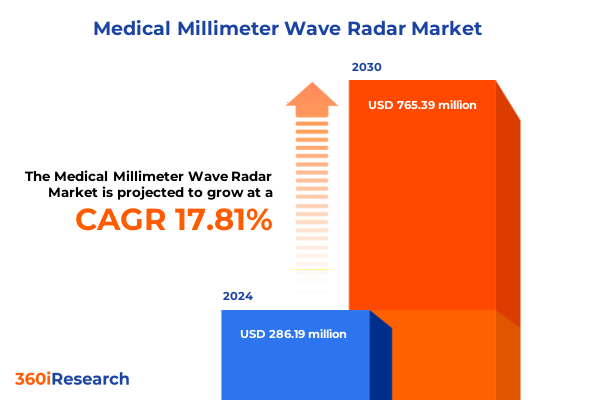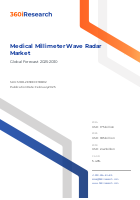The Medical Millimeter Wave Radar Market size was estimated at USD 286.19 million in 2024 and expected to reach USD 335.05 million in 2025, at a CAGR 17.81% to reach USD 765.39 million by 2030.

Introduction to Medical Millimeter Wave Radar Innovations
Medical millimeter wave radar represents a paradigm shift in non-invasive diagnostics, harnessing electromagnetic waves in the 30–300 GHz range to deliver unprecedented resolution for vital sign monitoring and imaging. Fueled by advancements in semiconductor fabrication, antenna design, and signal processing, these systems can detect minute physiological changes with sub-millimeter accuracy. As health systems embrace remote patient monitoring and point-of-care diagnostics, millimeter wave radar emerges as a versatile solution that transcends traditional limitations of ultrasound and infrared technologies. This introduction outlines the core principles of the technology, its key benefits in cardiology, neurology, oncology, and respiratory care, and the strategic relevance for medical device manufacturers, healthcare providers, and technology investors aiming to accelerate innovation and improve patient outcomes.
Transformative Technological Shifts Shaping the Market Landscape
Over the past decade, medical millimeter wave radar has benefited from a cascade of transformative shifts. First, the transition to integrated monolithic microwave integrated circuits has reduced component size while boosting performance and power efficiency. Next, advances in digital signal processing algorithms have enabled real-time extraction of heart rate, blood pressure, and respiratory patterns from raw radar echoes. Concurrently, the evolution of phased array antennas has unlocked dynamic beam steering, allowing continuous monitoring across multiple patients without physical contact. Moreover, the convergence of artificial intelligence and radar data analytics has elevated diagnostic accuracy, enabling automated anomaly detection and predictive insights. Finally, the broader healthcare landscape—marked by telemedicine expansion and regulatory incentives for remote monitoring—has created a fertile environment for adoption. Together, these interdependent shifts are reshaping how clinicians, researchers, and device developers engage with non-contact sensing technology.
Cumulative Impact of United States Tariffs in 2025 on Millimeter Wave Radar
In 2025, new United States tariff measures targeting imported electronic components have reverberated across the millimeter wave radar supply chain. Components sourced from key manufacturing hubs now face additional duties, prompting immediate cost pressures on amplifiers, digital signal processors, and antennas. As a result, device OEMs are accelerating qualification of alternative suppliers, while some have pivoted to domestic foundries to mitigate exposure. This redirection has underscored the value of diversified procurement strategies and stimulated partnerships between radar system integrators and U.S.-based chipset vendors. Although short-term pricing adjustments are inevitable, the fragmentation of supply chains ultimately fosters resilience, catalyzes local capacity building, and encourages investments in home-grown research and development. Consequently, the industry is on a trajectory toward a more balanced global ecosystem, where tariff-driven realignments coexist with innovation-led collaboration.
Insights from Market Segmentation Across Device, System, Frequency, Technology, Indication, Application, and End-User
When dissecting the market through component type, the technology portfolio spans amplifiers, antennas—encompassing patch and phased array configurations—compact MMICs, digital signal processors, radio-frequency transmitters, and receivers. System type segmentation distinguishes bi-static, monostatic, and multi-static radar architectures, each offering unique trade-offs in coverage, complexity, and cost. Frequency band analysis identifies sub-100 GHz solutions optimized for penetration, 100 GHz to 200 GHz variants balancing resolution and range, and above 200 GHz devices pushing the boundaries of spatial detail. Technology type segmentation highlights continuous wave radar for simple detection, frequency-modulated continuous wave radar for high-accuracy velocity measurement, and pulse radar for time-resolved imaging. Clinical indications drive the market across cardiology, neurology, oncology, and respiratory monitoring. On the application front, medical imaging leverages high-resolution scans, remote patient monitoring enables clinic-to-home connectivity, and vital sign monitoring captures blood pressure, body temperature, and pulse with respiratory rate metrics. Finally, adoption among ambulatory surgical centers, diagnostic imaging centers, and hospitals & clinics underscores the tiered demand environment, revealing where commercial focus and clinical investment converge.
This comprehensive research report categorizes the Medical Millimeter Wave Radar market into clearly defined segments, providing a detailed analysis of emerging trends and precise revenue forecasts to support strategic decision-making.
- Component Type
- System Type
- Frequency Band
- Technology Type
- Indication
- Application
- End-User
Key Regional Insights Across Americas, EMEA, and Asia-Pacific
Regionally, the Americas have assumed a pioneering role, driven by robust R&D funding, established regulatory pathways, and a vibrant ecosystem of device manufacturers and academic centers. In Europe, the Middle East & Africa, a mosaic of established healthcare systems and emerging markets has fostered pilot programs for remote monitoring, supported by harmonized regulatory frameworks and cross-border collaborations. Meanwhile, the Asia-Pacific region stands out for its rapid digital health adoption, high patient volumes, and cost-sensitive model, prompting local manufacturing expansions and strategic alliances with global technology leaders. Each geography exhibits distinct reimbursement policies, infrastructure maturity, and clinical priorities, shaping the technology’s uptake and product design. Understanding these regional dynamics enables stakeholders to align go-to-market strategies with regulatory requirements, reimbursement landscapes, and local innovation ecosystems.
This comprehensive research report examines key regions that drive the evolution of the Medical Millimeter Wave Radar market, offering deep insights into regional trends, growth factors, and industry developments that are influencing market performance.
- Americas
- Asia-Pacific
- Europe, Middle East & Africa
Key Company Profiles Driving Innovation in Millimeter Wave Radar
A diverse array of industry players is at the forefront of medical millimeter wave radar innovation. Analog Devices, Inc. and Infineon Technologies AG lead in high-frequency component design, while Asahi Kasei Microdevices Corporation and Nisshinbo Micro Devices Inc. advance compact MMIC solutions. Avnet, Inc. and Guangdong Ksourcing Exhibition Co., Ltd. facilitate global distribution and integration services, complemented by Vayyar Imaging Ltd.’s proprietary 4D imaging modules. Fujitsu Limited and Huawei Technologies Co., Ltd. focus on end-to-end system implementations, integrating radar with cloud analytics and AI. Keysight Technologies, Inc. and indie Semiconductor FFO GmbH contribute specialized testing platforms and power-efficient semiconductors. Jorjin Technologies Inc. and Mistral Solutions Pvt. Ltd innovate in embedded processing and signal fusion, while NXP Semiconductors NV and Texas Instruments Incorporated deliver versatile DSP and transmitter architectures. DALIAN IFLABEL TECHNOLOGY CO., LTD. and Shenzhen Minew Technologies Co., Ltd. emphasize sensor networks for distributed monitoring, and NOVELIC LLC BELGRADE pioneers low-power radar SoCs. Together, these companies form a dynamic network underpinning rapid commercialization and clinical validation.
This comprehensive research report delivers an in-depth overview of the principal market players in the Medical Millimeter Wave Radar market, evaluating their market share, strategic initiatives, and competitive positioning to illuminate the factors shaping the competitive landscape.
- Analog Devices, Inc.
- Asahi Kasei Microdevices Corporation
- Avnet, Inc.
- D3 Embedded
- DALIAN IFLABEL TECHNOLOGY CO., LTD.
- Fujitsu Limited
- Guangdong Ksourcing Exhibition Co., Ltd.
- Huawei Technologies Co., Ltd.
- indie Semiconductor FFO GmbH
- Infineon Technologies AG
- Jorjin Technologies Inc.
- Keysight Technologies, Inc.
- Mistral Solutions Pvt. Ltd
- Nisshinbo Micro Devices Inc.
- NOVELIC LLC BELGRADE
- NXP Semiconductors NV
- Shenzhen Minew Technologies Co., Ltd.
- STMicroelectronics International N.V.
- Texas Instruments Incorporated
- Vayyar Imaging Ltd.
Actionable Recommendations for Industry Leaders to Accelerate Growth
To capitalize on emerging opportunities, industry leaders should prioritize the following actions: forge strategic partnerships with local foundries to navigate tariff pressures while enhancing supply chain resilience; integrate machine learning frameworks into radar signal processing to differentiate product capabilities and expedite regulatory approvals; target high-growth clinical segments—particularly cardiology and respiratory monitoring—by co-developing pilot programs with leading healthcare institutions; invest in modular, scalable architectures that accommodate evolving frequency band requirements; pursue regional reimbursement alignment through engagement with payers and regulatory bodies; and cultivate a robust ecosystem of third-party component suppliers to ensure flexibility in sourcing. By executing these recommendations, organizations can accelerate time-to-market, reduce cost volatility, and strengthen competitive positioning.
Explore AI-driven insights for the Medical Millimeter Wave Radar market with ResearchAI on our online platform, providing deeper, data-backed market analysis.
Ask ResearchAI anything
World's First Innovative Al for Market Research
Conclusion: Navigating the Future of Medical Millimeter Wave Radar
Medical millimeter wave radar stands at the intersection of advanced electronics, computational analytics, and clinical innovation. Against a backdrop of shifting trade policies, evolving healthcare demands, and rapidly maturing technologies, stakeholders have an unprecedented opportunity to redefine patient monitoring and diagnostic paradigms. The intricate segmentation landscape—from component selection to end-user deployment—reveals targeted pathways for investment, while regional insights highlight where tailored strategies unlock maximal uptake. Meanwhile, a constellation of established and emerging companies underscores the collaborative momentum propelling the field forward. As the market matures, success will hinge on agility in supply chain management, commitment to regulatory excellence, and focus on integrated, AI-enabled solutions that deliver tangible clinical value.
This section provides a structured overview of the report, outlining key chapters and topics covered for easy reference in our Medical Millimeter Wave Radar market comprehensive research report.
- Preface
- Research Methodology
- Executive Summary
- Market Overview
- Market Insights
- Cumulative Impact of United States Tariffs 2025
- Medical Millimeter Wave Radar Market, by Component Type
- Medical Millimeter Wave Radar Market, by System Type
- Medical Millimeter Wave Radar Market, by Frequency Band
- Medical Millimeter Wave Radar Market, by Technology Type
- Medical Millimeter Wave Radar Market, by Indication
- Medical Millimeter Wave Radar Market, by Application
- Medical Millimeter Wave Radar Market, by End-User
- Americas Medical Millimeter Wave Radar Market
- Asia-Pacific Medical Millimeter Wave Radar Market
- Europe, Middle East & Africa Medical Millimeter Wave Radar Market
- Competitive Landscape
- ResearchAI
- ResearchStatistics
- ResearchContacts
- ResearchArticles
- Appendix
- List of Figures [Total: 30]
- List of Tables [Total: 419 ]
Call to Action: Engage with Our Research for Strategic Advantage
To secure a competitive edge, engage directly with Ketan Rohom, Associate Director, Sales & Marketing, to access in-depth analysis, detailed supplier evaluations, and bespoke market strategies. Contact Ketan at [email protected] or call +1-555-123-4567 to purchase the comprehensive market research report and partner in shaping the next frontier of non-contact medical sensing.

- How big is the Medical Millimeter Wave Radar Market?
- What is the Medical Millimeter Wave Radar Market growth?
- When do I get the report?
- In what format does this report get delivered to me?
- How long has 360iResearch been around?
- What if I have a question about your reports?
- Can I share this report with my team?
- Can I use your research in my presentation?




